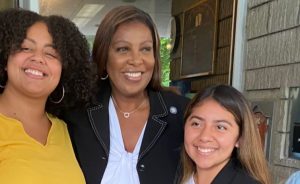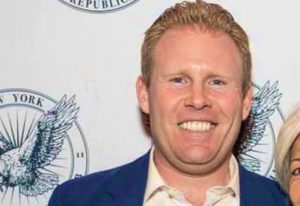
Gauging the Gubernatorial Gauntlet: A Handicapper’s Guide to the Applied Math of NYS Politics

In the wake of former Governor Andrew Cuomo’s fall from grace resignation, the state’s de facto political calendar has been moved into overdrive much earlier than expected. Contested gubernatorial primaries are expected in both the Democratic and Republican parties. Speculation is already rampant on who will emerge from both primaries and who will be the frontrunner in the general election. Public pollsters are already putting out surveys particularly on the Democratic side and that is likely to continue, probably on a monthly basis. This process will quickly turn into a political gauntlet for the candidates and their campaigns.
It is far too soon to handicap the outcomes with any precision. But it would be useful perhaps to provide a handicapper’s guide to the applied math of NYS politics. So let’s take a step back and not presume to know who will win, but instead to hold up a lens in front of the hard arithmetic of our state’s politics, which will become a gravitational force in and on next year’s gubernatorial campaign. My goal is to facilitate readers keeping the pundits honest, so that they can better gauge for themselves the accuracy of what will pass for the early conventional wisdom. I have found that understanding the applied math of New York politics is almost always a better predictor, than conventional wisdom, of the ultimate outcome of hard fought election campaigns.
Let’s begin with the Democrats. Here is how the vote breaks down regionally in a statewide Democratic primary:
- NYC casts 52-55 percent of the total vote (the higher the overall turnout, the higher NYC’s share).
- Upstate casts 25-30 percent of the total vote (the lower the overall turnout, the higher Upstate’s share of the statewide primary vote).
- The Suburbs (defined as Suffolk, Nassau, Westchester and Rockland) cast 19-20 percent of the total primary vote (regardless of the turnout level).
In terms of gender, 57-59 percent of the statewide Democratic primary vote is cast by women. In terms of ideology: 30-35 percent of the Democrats’ primary vote is cast by progressives (the lower the overall turnout, the higher the progressive share); 27-30 percent is cast by traditional liberals; 25-30 percent by moderates (the higher the overall turnout, the higher the moderate share); and 7-9 percent by conservative Democrats. The share of the vote cast by younger primary voters (those under 40 in age) is growing, but the votes cast by those over 45 in age usually hit or exceed the 60 percent share level in statewide primaries.
Within NYC, the Black vote casts 26-28 percent of the primary vote, Hispanics cast 18-22 percent, outer borough Jewish voters total 15-17 percent, White Catholics have melted down to only 8-10 percent, Asian voters are up to 7-11 percent, and LGBTQ voters (the toughest to quantify) are probably at a 9-10 percent share (but could be higher). Outside NYC, in the Suburbs the Jewish vote is 20-25 percent of the primary vote, while the Black vote is 18-22 percent and the Hispanic vote comes in at 10-15 percent, with the Asian vote heading towards cracking 5 percent, while the White Catholic share surges to just below or just about 40 percent in terms of the share of the total primary vote. Upstate, the Black vote is a solid 20 percent of the overall vote (its strength lodged in Upstate’s urban cores), the Hispanic share drops to 5-10 percent (but is growing), the Asian is just beginning to grow towards 2-3 percent of the vote, while those who are mainline White Protestants are in the low teens as are Jewish voters, with White Catholics in the low 40’s percentage wise. In short, the minority vote drives the outcome within NYC, but the White Catholic vote, supplemented by Jewish voters, power the outcomes in the suburbs of Upstate as well as Downstate.
Cutting across these racial, religious and ethnic voting blocs within Democratic primaries is an amorphous group of voters I have long called New Class voters. These are highly educated, professional (with jobs in both the private and not for profit sectors), often affluent voters, who lead a largely secular lifestyle. Within their ranks are many voters who grew up in Jewish and White Catholic families but who vote very differently than their parents and grandparents. They are mostly but not exclusively white, with many bi-racial and multi-racial voters now finding themselves in this category of New Class voters. LGBTQ voters and older reformers fall within the ranks of the diverse ranks of New Class voters. In national elections, these voters tend to look very liberal, especially on social and environmental issues, but in state and local elections large chunks of these voters are eclectic ideologically, gravitating to candidates like Michael Bloomberg and more recently Kathryn Garcia. The endorsements of editorial boards, especially the New York Times resonates with these voters. The ranks of the gentrified communities are swelling with New Class voters (i.e., Western Queens and the areas surrounding the Brownstone belt and now in Harlem as well).
In terms of share of the electorate, these New Class voters have grown from less than 15 percent of the of vote in New York City two decades ago, to having crossed 20 percent heading towards a quarter of NYC’s primary vote. New Class voters also form small but significant pockets of electoral strength in most Upstate cities (e.g., Rochester and Albany) and they drive the outcome of primaries in the lower, middle and upper Hudson Valley. New Class voters tend to be under 50 in age, but there are seniors in their ranks (e.g., the Upper West side and the East side of Manhattan). The New Class vote has the least penetration in terms of electoral share in the downstate Suburbs.
The Suburban fifth of the total primary vote is therefore more cohesive than Upstate’s quarter plus of the Democrats’ statewide primary electorate. Democratic primaries in the Suburbs are driven by the two largest counties in terms of votes cast: Nassau and Westchester, where the most likely coalition leading to victory is a coalition of traditional liberals and moderates centered among White Catholic, Jewish and Black as well as Hispanic voters. Upstate has multiple regions where different kinds of voters determine the outcomes in primaries. The progressives (drawing from the demographics underlying New Class voters) dominate in the narrow corridor from Peekskill north to Plattsburgh (a region that in Democratic primaries I like to impishly refer to as Vermont West). Traditional liberals and moderate voters dominate the small to medium to large sized metro counties from Buffalo all the way to the suburbs of the Capitol District. Meanwhile, in the smaller rural counties, older moderate and conservative Democrats determine the outcomes, west of Albany. In effect Albany County has become the point of passage or talisman for measuring whether the younger progressives can break through Upstate or whether the middle aged and older suburban voters will hold their traditional sway over Upstate in Democratic primaries.
In recent years, pundits often mistakenly project the left as ascendant in NYS’ Democratic primaries, because they arbitrarily lump the shares cast by progressives and traditional liberals. It is true that the progressive share has grown dramatically over the last 15 years from just about a fifth to just about a third of the total vote. But one large problem with that bit of conventional wisdom on the ascendant left, is that in recent primaries traditional liberals and moderates have gravitated away from the most progressive candidate, leading to large margins of defeat for the progressive candidate (Cuomo defeating Teachout by roughly 2-1 in 2014, Hillary Clinton defeating Bernie Sanders by double digits in NY’s presidential primary in 2016, Cuomo defeating Nixon in a landslide, James beating Teachout comfortably in a three way primary and Hochul defeating Jumaane Williams by 6.6 percent in 2018, with Biden defeating Sanders by an overwhelming margin in this state’s 2020 presidential primary).
Most of all, it is critical for progressives to realize that they can’t splinter their third of the electorate and expect to win statewide primaries. In truth, the progressives are ascending in NYS primaries, but they are not yet ascendant. To be ascendant, progressives must build broader coalitions to win statewide primaries. Instead of bridge building, however, progressives have tended to buy into the flawed conventional wisdom that they are ascendant and pursued political purity rather than bridge building, especially to voters 45 and older in age, of all races, ethnicities and education levels.
This year’s Democratic mayoral primary in NYC was an example, the turnout was relatively large (over 930,000 votes) and in the end Adams and Garcia, the two more moderate candidates, did much better than the progressive troika of Wiley, Stringer and Morales, which was underscored by the final round of Ranked Choice Voting, where Adams’ large lead among first place votes was reduced to a photo finish victory over Garcia in the end, where the progressives were nowhere to be found. Meanwhile, give the progressives their due, in this year’s Buffalo’s mayoral primary, India Walton’s campaign out-organized and out-hustled a complacent campaign on behalf of incumbent mayor Byron Brown and won that Democratic primary in a very low turnout. The question becomes, can Walton maintain her edge if the general election turnout surges, even as Brown faces all the daunting logistical hurdles of mounting a write-in campaign?
When you distill all this down, there are two coalitions that can win a statewide Democratic primary here in NYS. The most dependable path to victory comes from the iron triangle, within which the majority of statewide primary voters are found: it is the minority vote at its base, and along one side are white ethnic voters, with the third side being highly educated professional women voters. There is a lot of overlap within than triangle (e.g., the growing ranks of highly educated professional women of color). Nevertheless, if a candidate can dominate all three sides of the voters falling within this iron triangle they will win a statewide Democratic primary (e.g., Chuck Schumer, Hillary Clinton and Eliot Spitzer as well as Andrew Cuomo at their high water marks).
Alternatively, if a minority candidate could crack the base of the iron triangle mining minority voters and hold their own among either professional women and/or white ethnics (as James did in 2018 or Adams in this year’s mayoral race in NYC), by branching out regionally to suburban voters, as well as ideologically and in terms of race and ethnicity, they have a real chance to win a statewide primary. In theory, you could also say if a progressive white candidate could win if they snagged the lion’s share of minority voters, and go onto build regional bridges to white ethnics and/ or professional women, but no white progressive has of yet been able to meet that test of carrying minority voters in a high turnout statewide primary.

In the final analysis, I do not think anyone can accurately handicap next year’s gubernatorial primary unless and until, you know which candidates will be on the track when the race is run. The early polls, show that Governor Hochul is making serious strides to forge a formidable iron triangle coalition foundation for her candidacy. Not to mention that incumbency well- handled is a potent tool for any candidate. But it is still too early to dismiss Attorney General Tish James’ potential to put together a winning minority- progressive candidacy, provided she is not blown away in the Suburbs and Upstate west of Albany. Meanwhile, if the early polls are correct and if James has to fight hard to hold minority voters against some combination of Jumaane Williams, Bill DeBlasio and Andrew Cuomo (who like Spitzer in his race against Scott Stringer for Comptroller of NYC in 2013, has lost his white ethnic base and is now reduced to significant support only from minority voters, were Cuomo to shock the world and seek redemption so soon), that reduces James’ odds of success.

But let me be true to my postulate at the beginning of this piece, it is way too soon to calculate the odds of success and failure for the Democrats’ gubernatorial primary. Better to settle now for spotlighting the applied math of NYS politics, seeing it as it is, akin to a gravitational force to the ultimate outcome of this gubernatorial race.
In a Republican primary the regional shares shift dramatically from a Democratic primary:
- Upstate casts 60-65 percent of the total primary vote (where the Upstate share is driven higher by whether or not a strong Upstate candidate is in the race).
- The Suburbs cast 27-30 percent of the primary vote (driven by the turnout from Suffolk and Nassau on Long Island).
- NYC casts only 7-10 percent of the statewide primary vote and usually does not make double digits unless the turnout is very low overall.
Downstate, the White Catholic vote, especially the Italian American vote and the families with shared Italian and Irish roots, dominate GOP primaries. Within NYC, the GOP base is overwhelmingly made up of Italian American homeowners, heavily seniors and near seniors. Upstate the GOP base in the small to medium metro regions is heavily White Catholic (with a large dose of German Catholics, the nation’s first large group of ethnic immigration, in addition to the Irish, Italian and Polish families of mixed ethnic ancestry) anchored by Mainline Protestants. In the rural regions of Upstate, the party’s base is overwhelmingly Mainline White Protestants, with a healthy dose of Evangelicals who have left their family roots in Catholicism and the Mainline Protestant denominations.
The GOP’s conundrum is that to win a statewide general election they must secure not only their partisan base, but also sweep the large ranks of what we call Independent voters, which in our state are technically unaffiliated voters. And then to win, a Republican candidate must also significantly raid key Democratic voting blocs in NYC as Governor Rockefeller did in his time and the early Mayor Giuliani did among Jewish, White Catholic and Hispanic voters. Pataki and Bloomberg expanded upon those raids of Democrats, by doing very well among Asian and New Class voters as well as Jewish voters (beyond the orthodox and Hasidic share of the Jewish vote), in the 2002 gubernatorial and the 2005 mayoral elections.
The Republican problem today is that on issue after issue, their primary base demands fealty to conservative positions on abortion, guns and immigration that cuts their candidates off, not just from support from Independents, but about a quarter of moderate and traditional Republicans, not to mention the Democratic groups that they need to raid. Simply put, in order to win a Republican primary statewide, the stands taken usually pulls the Republican’s nominee too far to the right not just in NYC, but in the swing suburbs of Upstate as well as Downstate. The best example of this was in 2010, when Carl Paladino drove the turnout Upstate to form two thirds of the overall primary vote, to cement a large primary victory, but then wound up in a losing landslide to Cuomo, where Cuomo wound up narrowly carrying Upstate on his way to a landslide in the general election.
Compounding this problem is that the voters a Republican candidate needs to win in a general election, especially in terms of shaving the Democratic margins among key blocs in NYC (Hispanics, Asians, outer borough Jewish and yes older Black voters) are not to be found in a GOP primary. Consequently, a Republican candidate tends to emerge from a GOP primary without having made inroads into breaking down the Democrats’ registration edge based in NYC or among the crucial swing Independent voters outside NYC. In fact, coming out of the primary, the Republican nominee has rarely begun to even talk to the swing voters they would need to win the general election.

As an aside, if the most recent Siena poll is right, there is still some intra Republican heft associated with the Giuliani name within the cross tabs on Andrew Giuliani (Andrew Giuliani has a 42 percent favorability rating among Republicans, 48 percent favorability among self- identified conservatives and 23 percent Upstate; whereas in that same Siena poll, Zeldin’s favorability rating among Republicans is only 27 percent, 30 percent among conservatives and with a 12 percent favorability from Upstate voters). So if young Giuliani were to out hustle Zeldin Upstate in the Republican primary, I would not discount Andrew Giuliani pulling off an upset. Zeldin is simply not well known, Upstate or in NYC and even among Republicans. Meanwhile, in a general election if the callow Andrew Giuliani managed to pull off an upset in the GOP primary, he might just make Carl Paladino look like a vote getter in the general election.

In a general election, the regional balance of power shifts dramatically away from what drives the outcome in a Republican primary and significantly away from what wins in a Democratic primary. That sharp shift in the regional balance of power in a general election represents a continuing challenge for the Democrats, tests which they have passed since 2006, and which the Republicans have abysmally failed since Pataki’s third term victory in 2002. Here is how the general election breaks down regionally:
- Upstate casts 42-45 percent of the total vote (the lower the overall turnout, the higher Upstate’s share). From 1986- 2006 the Upstate share in a gubernatorial general election was higher falling in the 46-48 percent range.
- NYC casts 30-34 percent of the total vote (the higher the overall turnout, the higher NYC’s share).
- The Suburbs usually cast about 24 percent of the state’s overall vote (never below 23 percent or above a 25 percent share). Just under 70 percent of the Suburban vote in a general election is cast on Long Island.
Over the last 4 decades the once solid registration edges enjoyed by Republicans Upstate and in the Suburbs have been erased. The Democrats now have a narrow registration edge both Upstate and the Suburbs and huge 3 million plus registration edge from NYC. In reality outside NYC, where just shy of 70 percent of the total vote is cast in a gubernatorial general election, it is the break among Independent voters that determines who wins and loses Upstate and in the Suburbs.
So when you apply the math, for a Republican to win a two way race for Governor, would have to carry Upstate by 20 percent (60-40 percent), the Suburbs by about 12-14 percent (somewhere in the 56-44 percent to 57-43 percent range) and to have their share of the NYC vote equal the NYC share of the total vote (so if the NYC share of the total vote was 33 percent, the GOP’s gubernatorial candidate would have to snare 33 percent of the vote from NYC). Those tipping points for a GOP victory mean hitting all three of those markers, not just one or two. Yet, in no gubernatorial or presidential election since 2002 has a Republican candidate hit any of those regional tipping points. In fact, the Democrats carried Upstate in the gubernatorial elections of 2006 and 2010, losing it by an average of about 10 percent in 2014 and 2018. The Democrats carried the Suburbs by wide margins in 2006 and 2010, by a narrow margin in 2014 and by a medium margin in 2018. Meanwhile in NYC, the Republicans have not cracked the 25 percent share of the vote, often times losing by margins closer to 4-1 than 3-1. Back in 2002, Pataki crossed 40 percent of the vote within NYC.
In terms of gender, roughly 53 percent of the total vote is female and over a third are minority voters (the aggregate of Black, Hispanic, Asian and multi-racial voters). Roughly 33-35 percent of voters come out of White Catholic families, but just shy of half of swing voters are White Catholic (that mix of moderate Independents, conservative Democrats and Republicans who are liberal on the social and environmental issues even as they are fiscal conservatives). Consequently, in a general election garnering strong support from swing White Catholic voters is a necessity not a luxury for both parties.
When you distill all of this down, if Hochul emerged as the winner of the Democratic primary, she would be the Republican’s worst nightmare as a pro-choice, pro-environmental, Irish Catholic woman from Western New York, especially against a candidate like Zeldin who hails from eastern LI, with few real ties to Upstate and no discernable ties within NYC. Alternatively, if a Tish James won the Democratic primary, she would not be an easy target for the Republicans (e.g., she carried the Suburbs in the 2018 general election). At this point, the early polling data does not seem to give any other of the prospective Democratic candidates a chance to win the primary. But we ought hold off on any definitive handicapping. I truly believe that one can’t accurately handicap next year’s Democratic primary for Governor, unless and until it is known which candidates will be on the track when the primary race will be run.
But it is not too early to project that the Republicans have lot of work to do to be in a position to approach the three regional tipping points they would need to seriously compete for a victory in the 2022 gubernatorial race. The Republicans would have to find someone with George Pataki’s wingspan from the 1990’s, to seriously compete based upon today’s issues and themes. Therefore it does not surprise me that some GOP grandees are growing nostalgic, whispering for Pataki to come back and save their party by running for Governor. However, that earned nostalgia for Pataki appears wishful thinking, precisely because for now it appears that the Republican base is not ready to let such a candidate, grow much less spread such wings (on gun control, choice, the environment, immigration or most of all on fealty to Trump) to be in a position to seriously contend for victory in the gubernatorial election.
Right now the applied math of NYS politics looks like an equation the Republicans have no interest or commitment to solving. Nevertheless, if at some point complacency sets in among the Democrats, combining the inept handling of controversial issues tied to divisive primaries which rip apart the Democrat’s electoral coalition within NYC, while repelling swing voters in the Suburbs and Upstate, the Democrats will have opened the door for the Republicans to have a shot at winning the governorship. Finding the political discipline to fully take advantage of such an opportunity will become the acid test for any GOP revival in New York’s gubernatorial politics. In effect, the next real opening for the Republicans will only come when the Democrats ignore the gravitational furnace underlying the hard math encasing their primary’s iron triangle, which when smartly deployed forges a sword of steel in New York State’s general elections.
Bruce N. Gyory is a Democratic strategist and a Senior Advisor at the law firm of Manatt, Phelps & Phillips LLP, who used to teach a course in national and state voting trends as an adjunct professor at the University at Albany-SUNY.
